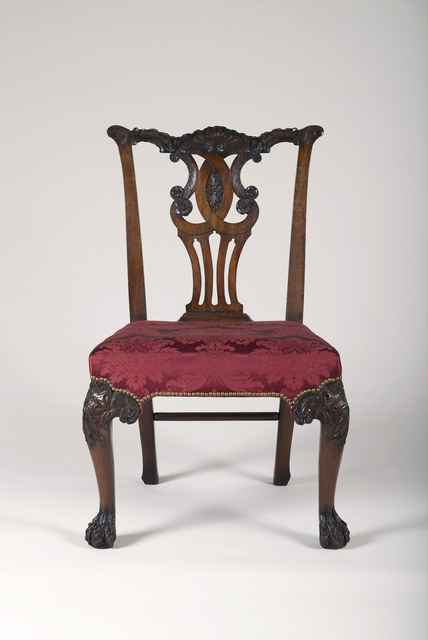Many people say “Chippendale” when they see a chair with a carved and pierced back. While it is true that Thomas Chippendale designed such chairs and his workshop produced similar models, the reason such chairs bear his name is because of the book of designs he published, The Gentleman and Cabinetmaker’s Director the first edition of which was in 1754. The book was aimed at both the patrons so they could select styles they liked and to cabinetmakers to show them good designs of what was fashionable. None of Chippendale’s designs have the hairy paw feet that this chair does. The chair’s pierced back was already in fashion when Chippendale’s Director first appeared, so this chair may well date from before Chippendale’s design book. His name is associated with the style because of the popularity of the book-well known on both sides of the Atlantic.
Chippendale was not the only one to publish rococo designs. Robert Manwaring, about whom less is known as he did not have a thriving cabinet shop, also published designs in the 1760’s that more closely resemble this chair than Chippendale’s. In fact, the deep rococo carving on the crest rail, on the knees and the hairy paws was especially popular in Ireland and, to a lesser extent, in Scotland. These chairs may have been made for a patron in either place, even if the maker and/or the design source was from London. Further complicating the story is the fact that London-trained furniture makers like Scottish-born Thomas Affleck, emigrated to Philadelphia where they too found a market for hairy paw chairs with pierced backs.
This chair is made of red walnut, a densely grained walnut that can look a lot like mahogany. Both woods were imported to England, the walnut often from Virginia. It was used for furniture-making after natural disasters such as a walnut blight and over use had exhausted first the English, then French walnut supply by about 1730. Mahogany from the Caribbean came to England in significant amounts starting in the 1720’s and was found especially desirable for carving, so walnut imports receded.
With wood imports and style that traveled via pattern books common, neither wood type nor design is a clue as to who made this chair. The style of carving is left as the factor to help determine authorship. Since so few pieces of British furniture were marked with a name, few makers are known by their style the way a painting might be-or stamped pieces of French furniture.
This maker did more than study pattern books; he-or someone he hired- knew how to do unusually fine carving. He also studied form–the chair is comfortable to sit in while providing decent posture in either a dining room or a living room setting of a grand house. Dining chairs in the mid-18th century were not left drawn up to the table but returned to a place along the wall when not in use. Such lavish knees and feet would be wasted under the table!
